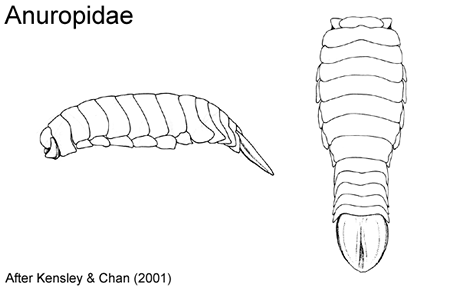 |
||||||
|
|
|
|
|
|
Australian Isopoda: FamiliesS.J. Keable, G.C.B. Poore & G.D.F. WilsonAnuropidae Stebbing, 1893 Anuropidae Stebbing, 1893: 345. -Roman & Dalens, 1999: 228. -Kensley & Chan, 2001: 487. Anuropodidae. -Jansen, 1981: 181. Description. Body. Body shape without loss or gross modification of appendages on one side of the body; in dorsal view without peduncular articles of antenna 1 or 2 contiguous with coxal margins. Head. Head not capable of lateral rotation (laterally encompassed, abutting or fused to pereonite 1). Antenna 1 inserting on head anteriorly and/or dorsally to antenna 2, minute or well developed; reduced to 2 articles with second article expanded and scalloped. Antenna 2 well developed. Mouthparts not forming suctorial cone or proboscis. Mandible not projecting anteriorly and together forceps-like; palp present. Pereon. Pereonites 6-7 pereonite 7 distinct dorsally, free. Coxae extending ventrally and laterally to overhang the coxa-basis articulation of the pereopods. Pereopods 6-7 pairs readily apparent; 1-3 or 1-7 not prehensile. Pereopods 5-7 without flattened setose articles andor dactyls modified or absent. Pleon / Pleotelson. Pleonites and pleotelson not arranged as follows: pleonites 1-5 fused but with conspicuous lateral sutures, pleotelson fused to pleonites 1-5; pleonites 1-5 fused but with conspicuous lateral sutures, pleotelson not fused to pleonites 1-5; pleonites 1-5 fused without conspicuous sutures, pleotelson not fused to pleonites 1-5; pleonites 2-5 fused but with partial (usually lateral) sutures, pleotelson wholly or partly fused with pleonites 2-5; pleonites 3-5 fused without lateral sutures, pleotelson fused with pleonites 3-5, pleonites 1 and 2 free but may be only small rings or cuticular bars visible ventrally. Pleonite 5 subequal to or shorter than any of pleonites 1-4. Pleopods 5 pairs present. Pleopod 2 of males not consisting of an enlarged peduncle with a geniculate endopod and a small muscular exopod. Uropods positioned proximally on pleotelson; folded ventrally below pleotelson, resembling pleopods but not forming operculum over them. Peduncle not forming an elongate clavate article with rami reduced or absent. Rami inserting on peduncle adjacent to each other. Endopod not claw-like (acute and recurved) andor posteroventral in position. Exopod not folded dorsally over pleotelson. Remarks. See Martin & Davis (2001) regarding the correct spelling of the family name. Distribution and generic composition. See Kensley et al. (1996).
Cite this publication as: 'S.J. Keable, G.C.B. Poore & G.D.F. Wilson (2002 onwards). 'Australian Isopoda: Families. Version: 2 October 2002. https://crustacea.net'. |
|
|
|
|
|
|
|
|
|
Copyright © Australian Museum, 2002 - 2003
Australian Museum website
